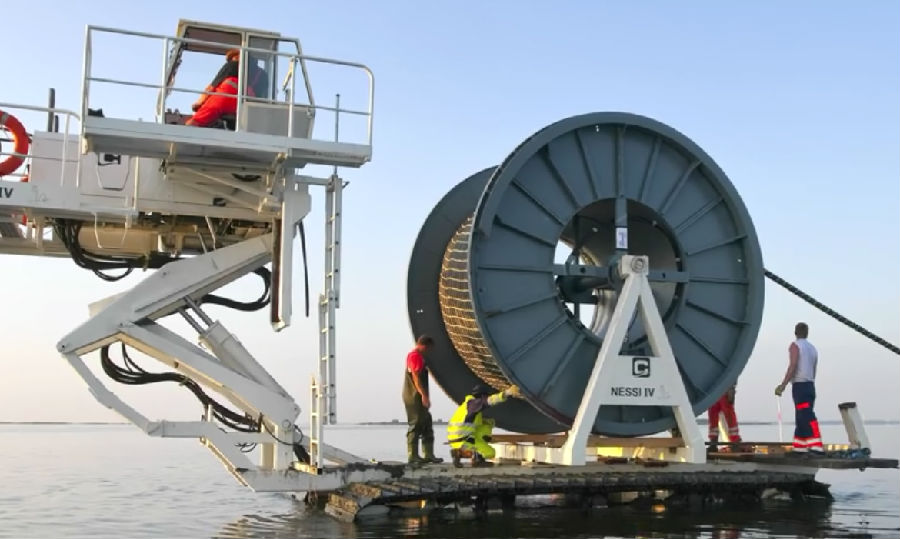(单词翻译:单击)
We never stop hearing about how the internet's in the cloud.
我们总是会听到互联网在云端的说法,
But really, it's in the ocean. About 300 undersea fiber optic cables are responsible for 99% of international data traffic.
但它其实是在海里:99%的国际网络通讯靠的都是海底的将近300条光缆。
It's basically the same way we connect to each other in a single country, except under water instead of underground.
这些连通各个国家的光缆就和连通同一国家不同地区的光缆一样,只不过它们是安装在海里的而不是在地底下。
They transmit PewDiePie from Europe to America and they connect stock traders in New York and London.
PewDiePie的视频从欧洲传到美国靠它们,连通纽约和伦敦的股民也要靠它们。
And these cables, placed by private companies, are the backbone of the internet, but if you held one in your hand it'd be no bigger than a soda can.
这些光缆,由民营企业负责安装,就是互联网的支柱,但放到大家手里也就易拉罐大小。
There are just a few layers of protection from the water, including petroleum jelly (yes, your internet is covered in Vaseline).
光缆外部只有几层防止海水侵蚀的保护层,其中一层还是凡士林(没错,你的网就是包在凡士林里的)
They're vulnerable to earthquakes, at least a few times, confused sharks have bitten them.
这些光缆不仅容易受到地震的破坏,被它们弄糊涂了的鲨鱼也咬过这些光缆。
But many cables are beneath sea life, because in some places they go as deep underwater as Mount Everest is high.
不过,很多都是埋在海洋生物生活范围之下的,有些甚至埋在了深度相当于珠穆朗玛峰高度的深海。
Ships lower a plow that digs a tiny groove in the ocean floor, lay in the cable, and it's naturally buried by sand, thanks to the ocean's current.
铺设光缆时,海船放下犁头在海床上挖一个浅沟,把光缆放进去,海浪就会自动带来泥沙盖住光缆。
And that process -- it's both stunningly simple and mindblowingly complex -- is responsible for making the internet a truly global network.
而正是这个过程——既简单得让人难以置信,又复杂地令人瞠目结舌——为真正实现互联网的国际化奠定了基础。
It's an idea that's audacious and crazy, and you think that it has to be cutting edge. And it is.
在海底铺设光缆的理念大胆而疯狂,估计也会用到尖端技术,事实就是如此,
But it's also been going on for 157 years.
但这一工作已经开展了157年了。
Electric telegraphs have been around for a long, long time.
电报已经有很长很长一段历史了。
Experiments in the early 1800s connected two ends of a garden, using a clock that revealed letters,
十九世纪初的实验用一个会显示文字的钟表连通了一个花园的两端。
then they moved on to two neighborhoods, to help signal trains, and then multiple cities, thanks to the network of railroad lines.
接着他们连通了两个社区帮助同步火车时刻信息,后来又实现了城市与城市的连通,幸好有铁路。
Underwater "submarine cables" were an obvious next step. So they played around.
在水下铺设“海底光缆”已经势在必行。所以他们就在海底玩起了光缆铺设。
Instead of petroleum jelly, the first ones were coated with exotic tree sap to protect them from the water.
为了保护光缆免受海水侵蚀,最初光缆外涂的并不是凡士林,而是某种奇异的树液。
And though the undersea cables came in spurts -- one of the first ones was knocked out of commission by a fishing boat --
尽管这些海底光缆会时不时地冒出来——最初一批光缆就有一部分被某条渔船带起来了——
and by 1858 they reached around the Atlantic and across the world.
到1858年,光缆已经遍布大西洋乃至世界各地。
And that's how it's kind of gone since, laying cables that circle the earth's oceans.
在世界各地的海底铺设光缆这一操作就这么一直持续到了现在。
The cables are unwound from the back of a ship, sink to the ocean floor, and the world is connected in speeds measured in milliseconds.
如今,光缆再也不会被船刮坏沉到海床上了,我们也已经有了毫秒级别的高速国际网络。
There are ideas to bring the internet above sea level.
如今已经有了很多将互联网光缆挪到海面以上的设想。
Along with cell phone towers, there's internet beamed from Facebook satellites to Africa and balloons lifted by Google.
除了手机信号塔,Facebook的卫星已经能将互联网信号发射到非洲,谷歌也放飞了能够发送网络信号的气球。
But for speedy international travel, undersea cables are still where companies like Facebook and Google place their bets.
然而,要获得快速的国际网络信号,海底光缆仍旧是Facebook和谷歌等公司主要的依靠。
That's because the best way to create the cloud is still by going under the sea.
因为海底光缆仍是创建云网络最好的方式。


